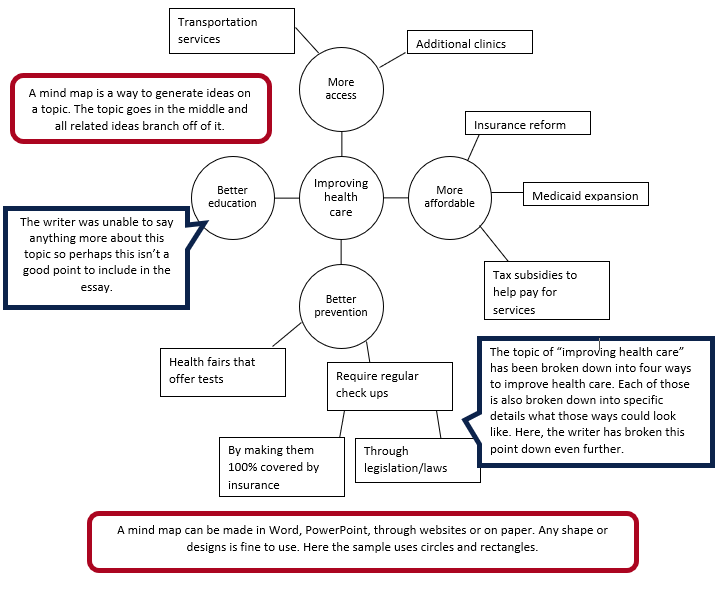If you’re struggling with writer’s block, don’t get discouraged. This happens to everyone at some point. Here are some techniques you can use to get back into the flow of writing:
Brainstorming is when you write down a list of ideas or words that you associate with your topic.
How to Brainstorm
- Write any words that come to mind when you think about your topic.
- Group the items that you have listed in a way that makes sense to you. For example, look for similarities or common themes.
- Cut any ideas that don’t fit into a group.
- Give each group a label. Each of these labeled groups will now be possible points of development in your paper
- Write a sentence about the label you have given each group of ideas. Now you have possible topic sentences.
Mind mapping, also called clustering, is a more visual way of representing ideas and concepts. It is especially useful in determining the relationship between ideas. Mind mapping lets you see your ideas in a different way, so that you can more readily understand possible directions your paper may take.
How to Mind Map
- Put the subject of your paper in the center of a page. Circle it.
- As you think of ideas, put those in circles and link the new ideas to the central circle with lines.These will be your main ideas related to your topic.
- As you think of ideas that relate to these main ideas, add these subtopics in the same way.
The result will look like a web on your page with multiple clusters of ideas. Pick clusters of interest to you, and use the terms you attached to the main ideas as development points for your paper.
Example of a Mind Map

Freewriting is when you write non-stop for a set amount of time without worrying about spelling, punctuation, or grammar. Even if you write nonsense, the act of forcing yourself to write can help you overcome writer’s block.
How to Freewrite
- Freewrite about your topic for 5-10 minutes non-stop. Just the act of writing will get your creative juices flowing!
- After you've finished freewriting, look over what you have written and highlight any key words or interesting ideas.
- Use those key words to begin the process over again, this time with a tighter focus. Eventually, you will generate several relevant points about the topic.
If you are stuck on what to write about, try using the six journalistic questions to get ideas for your paper. Here are some possible questions you can ask about your topic:
Who?:
Who discovered your topic? Who benefits from your topic? Who is affected? Who uses your topic?
What?:
What is your topic? What is the importance of the topic? What are the uses for your topic? What are the benefits of your topic? What are the issues?
Where?:
Where did your topic originate? Where is your topic used the most? Where does the problem or issue originate? Where is the cause of the problem most visible?
When?:
When was your topic made? When is the issue most apparent? When did the issue or problem develop? When is action needed to address the issue or problem?
Why?:
Why should we care about your topic? Why did you choose to write a paper on this topic? Why did the issue or problem arise? Why is your topic an issue or problem at all? Why did the issue or problem develop in the way that it did?
How?:
How is your topic related to other events? How is the issue or problem significant? How can it be addressed? How can the issue or problem be resolved? How is your topic changing? How has your topic changed our world?
Asking questions is a powerful way to develop a lot of information about a topic quickly. However, learning to ask the right questions about a topic takes practice. While writing, you may need to go back and ask who, what, where, when, why, and how questions again to expand on important points in your paper.